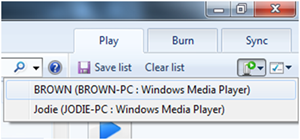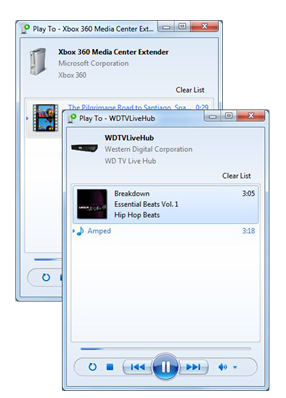I read an interesting thread over on Microsoft Answers recently in which the poster had purchased a “connected” TV with a DLNA (Digital Living Network Alliance) logo on it. He reported that he had no troubles navigating from his TV to the shared media libraries on his Windows 7 PC and playing the content, but when he tried to use Play To in Windows Media Player to send video content from his PC to his TV, he received an error message on his computer.
Put another way, he could easily pull content to his TV, but was unable to use Play To to push it there. Barb Bowman, one of our Windows Entertainment and Connected Home MVPs who has been writing about DLNA devices for years, quickly pointed out the issue: the TV was DLNA certified as a Digital Media Player (DMP) and not as a Digital Media Renderer (DMR), which is part of the Play To requirement.
While the original poster thought this was an issue of semantics, the reality is the difference between a DMP and DMR is pretty important, especially if you’re shopping for a new TV, and you will want to send media from your PC to it. I dug a bit further into what these differences are and why they’re important to you if, like me, you keep the bulk of your media on a Windows 7 PC.
Some quick background: DLNA was formed back in 2003/04 with the intention of providing guidelines that would make the emerging world of digital devices interoperate with each other seamlessly on a network. For a home network, devices fall into a few broad categories:
- Digital Media Server (DMS) – which stores content and makes it available on the network
- Digital Media Players (DMP) – which can play content pulled from a Digital Media Server
- Digital Media Controllers (DMC) – which can find content on a Digital Media Server and send it to a Digital Media Renderer device on the network
- Digital Media Renderers (DMR) – which can play content pushed to it from a Digital Media Controller
Windows 7, it turns out, implements all of these roles, which is why it makes a great hub for your home entertainment. In the case from Microsoft Answers cited above, the gentleman’s TV was DLNA Certified as a DMP, and thus it could find and pull content from the Windows 7 PC. However, when he tried to push content using Play To to the TV, he received an error on the host computer.
So, what’s the difference between a DMP and a DMR? On its website, DLNA uses different scenarios to illustrate the difference. Consider what they offer for a DMP…
Your movie collection is stored on your network attached storage (NAS), a certified digital media server (DMS). Instead of watching the movie on the little PC monitor in your office, you want to enjoy it on the large flat-panel TV in your living room. Because your DLNA Certified TV is certified as a digital media player (DMP), you can use the DMP capabilities of your TV to find the movies on your NAS, and then play them on the TV.
…versus their scenario for a DMR:
You have photos stored on your digital camera, a certified digital media controller (DMC). You want to look at them on your TV. With a DLNA Certified camera, you can send the photos to your DLNA Certified TV, which, if certified as a digital media renderer (DMR), can use those capabilities to display the photos.
The basic distinction here is that if you are looking for a connected TV that you can push content to from a Windows 7 PC using Play To, you need to ensure that it is DLNA certified as a DMR. Your best bet is to choose a TV that carries the Windows 7 logo on it. Microsoft maintains a list of Windows 7 logo’d devices that work with Play To, right here. If you see the DLNA logo on a device, be sure to check out the specs and make sure it’s the correct device type for your usage. You can also search for Play To receivers on the DLNA products page.
There are a lot of interesting possibilities when you get a number of DLNA devices on your network. We have several Windows 7 PCs in our home, and I can use Play To to push media to any one of them. Or, I can find media on one and push it to another.
Our TV is not DLNA-certified, unfortunately, but luckily we have an Xbox 360. Although it’s not certified as DLNA device, you can use Play To with an Xbox 360 if you have it set up as a Media Center Extender. Alternatively, you can Play To another DLNA-certified DMR device like a Western Digital TV Live Hub.
It’s worth noting, also, that while I can send most of my music, pictures and recorded TV around the network using Play To, I can’t send DRM’d content using it. So if you record a copy protected show using Windows Media Center, you can still only watch it on the device that recorded it, or on a v2 Media Center Extender like the Xbox 360.
As more DLNA devices come to market, more interesting media sharing scenarios are created – as I’m sure anyone who saw the sea monster commercial LG ran last year for the their LG Quantum phone can attest. Over the past year, we saw a wave of Blu-ray players roll out with DLNA certification (most of them as DMPs, by the way), and more and more printers and mobile devices are also getting certified. Barb has been writing in detail about different scenarios in her home, and offers this advice:
It is really important to check the DLNA actual certification levels that are listed for devices at dlna.org and if you do not see DMR (Digital Media Renderer) listed, you should not expect to be able to push all/some content to that device. Devices that are certified may even have difficulty negotiating a transcode format with the host for some file formats. The list maintained by Microsoft should be your ultimate guide.
Barb also notes that the benefits of DLNA begin to multiply as you add more devices to your network.
“Without leaving the comfort of your sofa, you can use a device like a laptop or tablet to RDP to a computer in another room (running Windows 7 Professional and above) and start a Play To stream to the TV or other DMR device in your living room, “she writes.
For More Information
The soup-to-nuts view of Windows 7 media sharing was detailed back in 2009 on the Engineering Windows 7 blog. Over at TheDigitalLifestyle.com, the community maintains a wiki entry of Play To devices they’ve actually tested themselves, and as always, the folks at TheGreenButton.com, our Windows Media Center enthusiast community, are eager to help you out. I’d start in the Play To, DLNA and WiDi forum.


